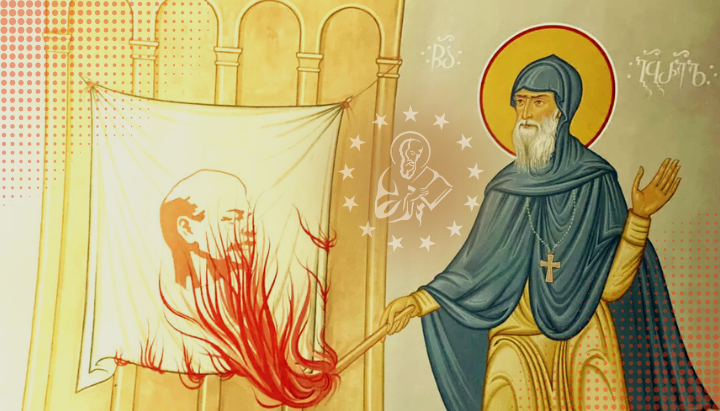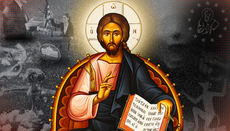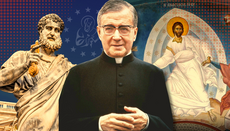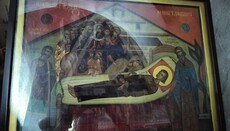Why Did St. Gabriel of Georgia Burn the Flag of Lenin?

Recently the Orthodox Church celebrated the feast day of St. Gabriel Urgebadze of Georgia, the fool for Christ. A hieromonk who lived during the Soviet Union, he experienced intense persecution, especially during the post Stalin era. Some mainstream liberal historians have made the Soviet Union appear to be a much nicer place after the death of Joseph Stalin in 1953, during the rise of Nikita Khrushchev and his policy of “de-Stalinization." However, this couldn’t be further from the truth, as the life of St Gabriel shows.
In order to understand St. Gabriel of Georgia's famous act of defiance—his burning of an image of Vladimir Lenin, founder of the Soviet Union, in 1965—we must consider the historical context.
The persecution of Orthodoxy that emerged within the USSR during the post-Stalin period has been often overlooked, as the main focus tends to be on the early years after the Bolshevik Revolution during the Civil War, the Renovationist schism, the League of Militant Atheists in the late 1920s and early 1930s, and of course the terror of Nikolai Yezhov in which over 100,000 Orthodox Christians were martyred in 1937 alone.
During the reign of Nikita Khrushchev, persecution of the Orthodox Church was renewed after it had previously been halted by Stalin in the late 1930s and early 1940s. Churches and monasteries that remained standing or were reopened by Stalin were shut down. The new form of persecution may not have been as violent. However, this only made it more “effective.”
It should be emphasized that Khrushchev was very much inspired by Trotsky. This is especially true of his “secret speech,” in where he condemns Stalin for the so-called crimes he committed and brings up the idea of “Lenin's Testament.”
The original document can be found in Grover Furr’s Khrushchev Lied, where he describes how this was a letter by Lenin who at the time just had a stroke, and it was advised for his wife to not talk politics to him as to not disturb him and help him recover, of which Stalin was put in charge of her. She did not listen. Stalin rebuked her as a result, leading to her to complain to Lenin—thus provoking Lenin to write a letter where he basically says Stalin is rude. Trotsky later took this letter as “proof” that Lenin wanted him to be the successor as opposed to Stalin.
This couldn't be further from the truth. Nevertheless, this notion of Lenin being a Trotskyite—popularized by Khrushchev!—led to a revitalization of Trotskyism and a surge of idol-worship of Lenin.
According to Lenin’s wife, his dying wish was to not be turned into an object to be idolized. Interestingly enough, according to Stephen Kotkin in Stalin Volume I, she also testified that the last event Lenin went to were Orthodox Christmas festivities at Gorki.
This would explain why St. Tikhon of Moscow took such a nuanced view of Lenin. Even after being released from prison, St. Tikhon continued to issue statements upholding his position of honoring the governing authorities in light of Romans 13. After the death of Lenin in 1924, he published a statement in the Evening Moscow in which he said Lenin was not excommunicated from the Church. St. Tikhon said that, although he would not do so himself, all believers have a right to commemorate Lenin, explicitly stating he had a “truly Christian soul.”
On St Tikhon’s deathbed in his final testament published in Izvestia on April 15, 1925, he even praised the USSR as a “truly worker-peasant government,” calling it “strong and unshakable.” (To any skeptics who might be reading this, St Hilarion Troitsky insists that these teachings were genuine and offered out of humility, dismissing the idea that St. Tikhon acted under duress or that the documents were forged.)
All of the above could suggest that Lenin had a deathbed conversion. If this is true, then—ironically—those who flew the banner as an idol would be going against Lenin himself!
This is the context in which St. Gabriel of Georgia burned the flag of Lenin. He was not simply attacking Lenin. On the contrary: this gesture was primarily a warning to the crowd about the dangers of idolatry.
After his demonstration, St. Gabriel stood on the second floor of the balcony and gave a sermon saying:
The Lord said, “You shall have no other gods before Me. You shall not make for yourself an idol or a likeness of anything in heaven above, or in the earth beneath, or in the waters under the earth. You shall not bow down to them or serve them, for I, the Lord your God, am a jealous God…” (Exodus 20:3-5). People, come to your senses! The Georgians have always been Christians! So why are you bowing down before idols? Jesus Christ died and rose again… But your cast idols will never be resurrected.
Though Khrushchev was no longer the head of the USSR, the policies set forth by his regime would not be lessened until Brezhnev came to power until the 1970s. Therefore, as a result of his “crimes,” St. Gabriel was imprisoned and almost beaten to death. Eventually, he was released on the grounds of “insanity.” In reality, however, he was a Fool for Christ. St. Gabriel never lost faith in God, standing firm in his obedience to the Holy Orthodox Church.
Lenin may have indeed been an evil monster as he is often portrayed, but that is ultimately up to God to judge. The idea that St. Gabriel hated Lenin would be slander against his character, as the Holy Scriptures make it clear we must even love our enemies.
The reality is that St. Gabriel did not burn the flag out of hate or judgement of Lenin, but rather out of love for the Georgian people, who had once been very pious Orthodox Christians, and had now twisted the image of Lenin, turning him into an idol and an object of worship.
St. Gabriel of Georgia, pray to God for us!
The views expressed in this article belong to the author and do not necessarily reflect the position of the Union of Orthodox Journalists.









